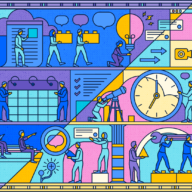
Special Report
The state of teams
A study by Atlassian reveals it’s not where you work
but how you work that makes teams thrive.
Companies are only as healthy as the teams that compose them.
When teams are thriving, they show up for customers, stakeholders, and each other. But what does “healthy” even mean? And what factors influence a team’s health for better or worse?
With those questions in mind, we surveyed teams of all shapes and sizes across many industries to discover the current state of team health in Australia and the U.S.
Across geographies, we found that the majority of teams are striving to find the magic combination of practices, people, and purpose that will get them into a high-performance groove. Our research suggests eight factors that influence team health, and (spoiler alert!) where teams work isn’t one of them.

“Leaders have waxed lyrical for years that people are their biggest asset. Yet, the data shows we’re not delivering on our promises and consequently our teams are far from reaching their full potential.”
DOM PRICE
Work Futurist, Atlassian
Part one
Trends worth tracking

Does location really matter?
Apparently not. Healthy teams are found in all working environments: co-located in an office, fully remote, or a hybrid of the two. In fact, remote and hybrid teams appear to have a leg up! In other words, the push to get workers back into the office is counter-productive.
Remote Teams
Hybrid Teams
Office Teams

Organizational culture definitely matters
We picked up strong signals indicating that a supportive environment with the right people, collaboration rituals, and cultural norms makes
a massive difference:
Trust in leadership
Respect for diverse viewpoints
Transparent decision-making
Skill and personality fit
Well-defined roles
Clear goals and strategies
Coordination in and outside the team
Psychological safety

Healthy teams are connected, collaborative, and crushing it
In our study, members of healthy teams noted feeling a sense of belonging and support for new ideas. This creates an environment of high engagement, which, in turn, serves as a buffer against burnout and fuels even higher performance.
“Our organisation is willing to take risks, there’s not a lot of hierarchy and we are encouraged to use our initiative. It is enabling and progressive and feels like anything is possible.”
-Research participant

Where are teams
working right now?
Office only
Remote
Hybrid
Part two
What’s this research all about?
Atlassian’s State of Teams project seeks to provide a framework for tracking team health over time. In partnership with research consultancy Paper Giant, we’re capturing factors like engagement, performance, cultural norms, and long-term viability. In addition to providing a macro-level view across industries, the State of Teams project also links specific practices and attitudes to team health outcomes. Leaders will be able to use these insights to foster healthier, happier teams.
Our initial wave of data shows that it’s not where you work that matters, but how you work. Will this still be true in six months? We don’t know! But we’re excited to find the answer to this and many other questions in our next wave. Watch this space!

“We’re so distracted figuring out where teams should be working that we’re missing the bigger picture on team health. Factors such as burnout, team and organizational culture, and the team’s ways of working are so much more important than whether a team is remote, co-located, or hybrid.”

68%
of healthy teams are hybrid or fully remote
You’ve got questions, the data has answers observations
Let’s take a deeper look into what the numbers suggest about what really matters and how managers can improve their team’s health.

What are the most common struggles?
Only 34 percent of teams landed in the healthy range when it comes to measures of team climate. (Think of “climate” as a team’s overall vibe, capturing elements like team cohesion and psychological safety.) 56 percent feel their team is poorly connected on a personal level, and 37 percent feel like they can’t try new things or express themselves fully.
Performance is another area of concern. 57 percent of study participants said their team isn’t operating as efficiently as it should, and 12 percent say it’s gotten so bad they’re letting their stakeholders down.
57%
said their team isn’t operating as efficiently as it should


What actually drives team health?
While the internet has been losing its collective mind over remote vs. in-office, a host of other factors – such as team dynamics, support structures, rituals, and processes – appear to be quietly making the real difference between healthy and unhealthy teams. Here are some common threads we found among the healthiest teams, listed to the right.
And while members of even the healthiest teams are susceptible to burnout, our findings (strongly) suggest that flexible practices and a supportive environment can offset the impact of challenging personal circumstances. This is particularly important for teams that include parents of young children or other caregivers. 45 percent of participants with high care responsibilities report experiencing burnout.
- A shared understanding of the team’s goals and each person’s role in pursuing them
- Adaptive planning practices that allow for adjusting the plan when the situation calls for it
- A culture that celebrates achievement (but doesn’t punish failure)
- Regular opportunities to reflect in a blame-free environment
- Timely, constructive feedback that flows both ways between managers and their direct reports

97%
of teams whose culture supports innovation make time to reflect and incorporate lessons learned.
Part three
What should
leaders focus on?
We’ve established that in-office, remote, and hybrid teams are all viable. Here’s what leaders should turn their attention to instead.


Organizational values that empower
- Be candid about your own shortcomings so as to foster greater trust in leadership.
- Elevate the importance of diverse viewpoints and make space for respectful dissent.
- Facilitate open decision-making. Delegate decisions when it’s possible, and ask team members for input when it’s not.

An equitable, humane team climate
- Recognize those who go out of their way to support their teammates and strengthen team cohesion.
- Understand the circumstances and lived experiences of your team members to help prevent bias from creeping in.
- Assess for change fatigue and burnout before making major changes to team structure, processes, or where the team works.

Support for innovation
- Openly discuss what has worked, what hasn’t, and what improvements could be made.
- Carve out time to explore new ideas, both individually and as a team.
- Make space for calculated risks and incorporate the lessons you learn.
- Adopt rituals designed to improve planning and collaboration.
About this research
1568 knowledge workers across Australia and the U.S. participated in this study (535 from Australia; 1033 from the U.S.) The population of interest of this research was knowledge workers aged between 21 and 65 operating in teams. The average age of participants was 45.3 years (standard deviation = 10.95 years). The sample comprised of 50.7% women and 49.3 men.
The survey administered to participants was 15 minutes in length. Questions included demographic data, and variables informed by relevant organisational psychology literature (e.g., organisational culture, team health). Our analyses included descriptive statistics and regression analyses. The margin of error is +/-2% for the entire sample based on a 95% confidence level.
45.3 years
the average age of study participant
50.7%
women
49.3%
men














































